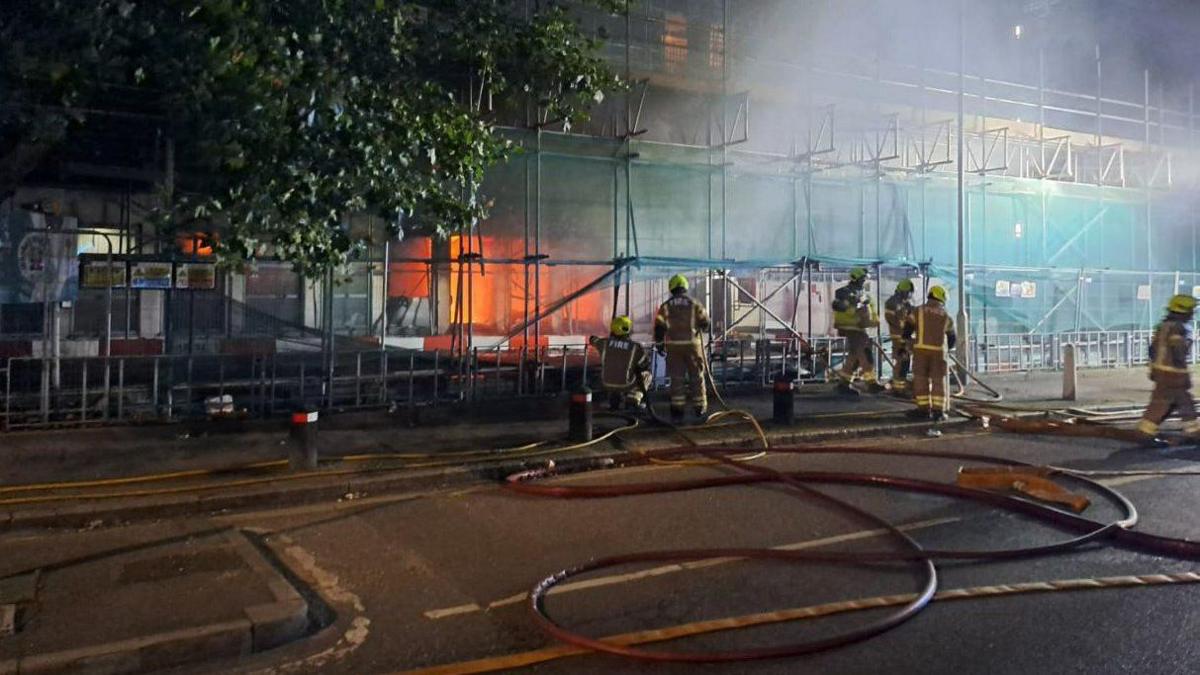'We somehow got out' of London tower inferno
Drone footage shows firefighters tackling Dagenham blaze
- Published
Dinesh Raj wasn’t at home with his six-year-old when the fire broke out.
He got the call at 03:00 BST on Monday that flames were racing up the side of the tower block in east London, he told the BBC, and raced to the scene.
Fortunately, by then his friends Karthick and Meghana Kannaiah had already scooped up his daughter, and together with their own six-month-old baby, headed for the exits.
Mr Kannaiah said he had opened his window to see flames after his wife told him the scaffolding outside was on fire.
"It was as though I was seeing a horror movie," he said.
"We opened the door and saw people rushing towards the stairs. We somehow got out of the building with our baby."

Dinesh Raj's six-year-old daughter was sleeping at a friend's flat in the building
By the time they were out of the building, the fire had spread to the top floor. Mr Raj arrived to see the building in Dagenham in flames.
Another resident, Tariq Ziad, 17, told the BBC he fears his family has lost everything.
He described seeing smoke quickly fill his fourth-floor flat as flames engulfed the building in the early hours of Monday morning.
More than 80 people were evacuated, with two taken to hospital. All of the building’s occupants have now been accounted for, according to London Fire Brigade (LFB).
The fire service has said the building has "known" safety issues, and the role cladding played will form part of the investigation.
Around 225 firefighters were deployed to the scene on Freshwater Road at 02:45 BST as the fire took hold in the building, including the scaffolding around it and the roof.
A major incident was declared by the fire service. It has now been stood down but crews will remain at the scene into Tuesday, the LFB said.
Mr Ziad lives in the mixed-use commercial and residential building with his dad, and the pair knocked on their neighbours' doors to raise the alarm before rushing down to safety.
"One breath of [smoke] clenches your lungs, you can’t breathe, it attacks you," he said.
Mr Ziad said he believed some of the fire alarms did not seem to be working, as he pressed two - next to the stairs on the fourth floor, and at the entrance - and one made a noise for a slight second "but there was no siren".
"It’s a bit of a hectic thing, I'm still trying to let it sink in. We’ve lost everything but it is what it is at the end of the day," he said.
'Everybody was scared' - Dagenham resident who escaped fire
A resident who lives on the first floor of the building told the BBC he was awoken in the early hours of Monday morning by one of his neighbours frantically banging on his door.
The resident, who did not wish to be named, said his neighbour had been doing the same for all the flats in the corridor.
He said he saw "explosive" flames and was relieved to get out safely.
Evacuated residents have been taken to a rest area that has been set up at a nearby leisure centre.
London Fire Assistant Commissioner Patrick Goulbourne said: "The building has a number of fire safety issues known to London Fire Brigade."
Questions around the role of cladding in the fire will form part of the full investigation into the incident, he added.
It is not yet known what caused the fire, but according to a Facebook post from a contractor, external the building's "non-compliant" cladding was in the process of being removed.
A planning application document also details "remedial" work being undertaken to remove and replace "non-compliant cladding" on the fifth and sixth floors containing flats.

Hours after the fire broke out, smoke continued to billow from the roof and the scaffolding that surrounded the Freshwater Road building
Mr Goulbourne also urged people to avoid the area, adding that residents should keep doors and windows closed as the blaze was still producing heavy smoke.
The Fire Brigades Union (FBU) said the incident exposed the "'national scandal' of flammable cladding and deregulation in the building industry".
"Once again, a fire has erupted in a residential building wrapped in flammable cladding. There needs to be an urgent and swift investigation of how this has been allowed to happen," a statement said.
Grenfell United - a campaign group set up to support survivors and bereaved families following the Grenfell Tower fire in 2017 - said the Dagenham fire highlighted "a lack of urgency for building safety", in a statement published on social media.
The group said the fact that the building had a number of fire safety issues "highlights the painfully slow progress of remediation across the country" and called on the government to speed up the process.

Forty fire engines were called to the blaze which broke out in Freshwater Road in Dagenham
In 2022, the government introduced the Building Safety Act - in response to the Grenfell Tower fire - making sure most leasehold owners of flats were protected from the costs of dangerous cladding.
The government also introduced a scheme forcing developers and social landlords to take steps to replace unsafe cladding, or risk facing being banned from building residential properties in England.
According to government figures published last week, 4,630 residential buildings measuring 11m and over in height have been identified as having unsafe cladding as of the end of July this year.
Half of these buildings have started or completed works to remove the cladding. Only 29% of these buildings have finished remediation works.
A final report on the Grenfell Tower Inquiry is due to be released next week.
Get in touch
Have you been affected by the fire? If it is safe to do so, share your experiences.